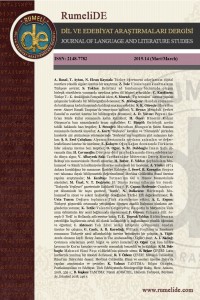Abstract
Divan edebiyatının altı yüz yıllık gelişiminde
farklı nazım şekilleri ve türlerine rastlamak mümkündür. Klasik Türk
edebiyatının şeklî kuralcı yapısı içerisinde siyasî ve kültürel ortamın etkisi,
sanatçıların yenilik arayışı ve estetik kaygıları gibi nedenlerle yeni türler
ortaya çıkmıştır. Klasik edebiyatımızda “sefer, teşrif ve tebrik” temelli
türlerden biri de kudûmiyelerdir. Kudûmiye; büyük ve önemli zâtların bir
seferden avdeti veya bir şehre teşrifi vesilesiyle takdim olunan armağana
denir. Edebî bir terim olarak kudûmiye; büyük ve önemli bir zâtın seferden
dönmesi veya bir şehre teşrifi vesilesiyle yazılan, avdetin veya teşrifin
tebrik edilip şairin ve halkın üzerindeki duyguların yansıtıldığı, dönen veya
teşrif eden kişinin methedildiği manzumelere denir. Bu çalışma 17. yüzyıl
sanatçılarından Şeyhülislam Hocazâde Mehmed Efendi ve 19. yüzyıl
sanatçılarından Mehmed Sâmih’in kaside nazım şekliyle yazdıkları kudûmiyelerin
mukayeseli olarak incelenmesinden oluşmaktadır. Çalışmada öncelikle klasik Türk
edebiyatında kudûmiyeler ve kudûmiyelerin diğer türlerle ilişkisi hakkında
bilgi verilmiş, ardından farklı yüzyıllarda yazılmış ve farklı kişilere
sunulmuş iki kudûmiye, şekil ve muhteva açısından incelenmiştir. Yazının
sonunda iki kasidenin transkripsiyonlu metni de verilmiştir.
References
- Akkuş, Metin (1993). Nef’î Divanı. Ankara: Akçağ. Akkuş, Metin (2007). Klasik Türk Şiirinin Anlam Dünyası Edebi Türler ve Tarzlar. Erzurum: Fenomen Yayınları. Aydemir, Yaşar (2004). Methiye. TDV İslam Ansiklopedisi (C. 29, S. 410-411). Ankara: TDV. Çalışkan Nurettin & Ünal, Mehmet (2018). Mehmet Sâmih’in Üsküp Valisi Müşir Mustafa Paşa Medhiyesi Bağlamında Bir Tarihi Dönem İncelemesi. Uluslararası Sosyal Araştırmalar Dergisi, 11/61, 64-75. Çiftçi, Ömer (1996). Fatîn Davud Hâtimetü’l-Eş’âr (Fatîn Tezkiresi), Yüksek Lisans Tezi, İnönü Üniversitesi, Malatya. Devellioğlu, Ferit (2004). Osmanlıca-Türkçe Ansiklopedik Lûgat. Ankara: Aydın Yayınları. Ertuğrul, Züleyha Nurgül (2018). Klasik Türk Edebiyatında Kudûmiye. Yüksek Lisans Tezi, Gazi Üniversitesi, Ankara. İnal, İbnü’l Emîn Mahmud Kemal (1988). Son Asır Türk Şairleri III, İstanbul: Dergâh Yayınları. İpşirli, Mehmet (2003). Mehmed Efendi Hocazâde. TDV İslam Ansiklopedisi (C. 28, S. 452-453). Ankara: TDV. Kocakaplan, İsa; Gökalp, Haluk; Aça, Mehmet (2012). Başlangıçtan Günümüze Türk Edebiyatında Tür ve Şekil Bilgisi. İstanbul: Kesit. Küçük, Sebahattin (2018). Bâkî Divanı. http://ekitap.kulturturizm.gov.tr, (Erişim Tarihi: 01.01.2018). Mehmed Süreyya (1996). Sicill-i Osmanî 5, (Haz: Nuri Akbayar), İstanbul: Tarih Vakfı Yurt Yayınları. Odabaşı, Mihrican (2009). Tuhfe-i Nâilî Metin ve Muhteva, Yüksek Lisans Tezi, Cumhuriyet Üniversitesi, Sivas. Ölmez, Ahmet (1996). Behceti Hüseyin Efendi Divan (Hayatı-eserleri ve Divanının Tenkidli Metni). Doktora Tezi, Erciyes Üniversitesi, Kayseri. Pala, İskender (2003). Ansiklopedik Divân Şiiri Sözlüğü. İstanbul: L&M Yayınları. Sami, Şemseddin (2009). Kâmûs-ı Türkî, İstanbul: Çağrı Yayınları. Tuğluk, Halil İbrahim (2010). Divan Şiiri’nde Manzum Tebrik-nâmeler. A. Ü. Türkiyat Araştırmaları Enstitüsü Dergisi, 42, 41-68. Tuman, Mehmed Nâil (2001). Tuhfe-i Nâilî-Divan Şairlerinin Muhtasar Biyografileri II, (Haz: Cemal Kurnaz, Mustafa Tatcı), Ankara: Bizim Büro Yayınları.
Abstract
It is possible to find different forms and types
of divan literature in its six hundred years of development. Within the
prescriptive structure of classical Turkish literature, new species emerged
with the effect of political and cultural environment, artists' quest for
novelty and aesthetic concerns. In our classical literature, one of the species
based on ud “expedition, honour and greeting”is kudumiye. Kudum to; the great and
important person is called a gift or a gift that is presented to a city. As a
literary term, kudumiye is called poems, in which a great and important person
is returned from the expeditionor written on the occasion of his dissemination
to a city, where he is congratulated, the emotions on the poet and the public,
and the person returning or praising is praised. This study consists of
comparative study of the 17th century Shaykh al-Islam Mehmed Efendi and the 19
th century Mehmed Sâmih in the form of kasida. In this study, firstly some
information about kudumiye and the relation betweenother species in classical
Turkish literature. Will be given and the two kudûmiye written in different
centuries and presented to different people will be examined in terms of form
and content. At the end of the article, the transcribed text of both kasidas
will be given.
References
- Akkuş, Metin (1993). Nef’î Divanı. Ankara: Akçağ. Akkuş, Metin (2007). Klasik Türk Şiirinin Anlam Dünyası Edebi Türler ve Tarzlar. Erzurum: Fenomen Yayınları. Aydemir, Yaşar (2004). Methiye. TDV İslam Ansiklopedisi (C. 29, S. 410-411). Ankara: TDV. Çalışkan Nurettin & Ünal, Mehmet (2018). Mehmet Sâmih’in Üsküp Valisi Müşir Mustafa Paşa Medhiyesi Bağlamında Bir Tarihi Dönem İncelemesi. Uluslararası Sosyal Araştırmalar Dergisi, 11/61, 64-75. Çiftçi, Ömer (1996). Fatîn Davud Hâtimetü’l-Eş’âr (Fatîn Tezkiresi), Yüksek Lisans Tezi, İnönü Üniversitesi, Malatya. Devellioğlu, Ferit (2004). Osmanlıca-Türkçe Ansiklopedik Lûgat. Ankara: Aydın Yayınları. Ertuğrul, Züleyha Nurgül (2018). Klasik Türk Edebiyatında Kudûmiye. Yüksek Lisans Tezi, Gazi Üniversitesi, Ankara. İnal, İbnü’l Emîn Mahmud Kemal (1988). Son Asır Türk Şairleri III, İstanbul: Dergâh Yayınları. İpşirli, Mehmet (2003). Mehmed Efendi Hocazâde. TDV İslam Ansiklopedisi (C. 28, S. 452-453). Ankara: TDV. Kocakaplan, İsa; Gökalp, Haluk; Aça, Mehmet (2012). Başlangıçtan Günümüze Türk Edebiyatında Tür ve Şekil Bilgisi. İstanbul: Kesit. Küçük, Sebahattin (2018). Bâkî Divanı. http://ekitap.kulturturizm.gov.tr, (Erişim Tarihi: 01.01.2018). Mehmed Süreyya (1996). Sicill-i Osmanî 5, (Haz: Nuri Akbayar), İstanbul: Tarih Vakfı Yurt Yayınları. Odabaşı, Mihrican (2009). Tuhfe-i Nâilî Metin ve Muhteva, Yüksek Lisans Tezi, Cumhuriyet Üniversitesi, Sivas. Ölmez, Ahmet (1996). Behceti Hüseyin Efendi Divan (Hayatı-eserleri ve Divanının Tenkidli Metni). Doktora Tezi, Erciyes Üniversitesi, Kayseri. Pala, İskender (2003). Ansiklopedik Divân Şiiri Sözlüğü. İstanbul: L&M Yayınları. Sami, Şemseddin (2009). Kâmûs-ı Türkî, İstanbul: Çağrı Yayınları. Tuğluk, Halil İbrahim (2010). Divan Şiiri’nde Manzum Tebrik-nâmeler. A. Ü. Türkiyat Araştırmaları Enstitüsü Dergisi, 42, 41-68. Tuman, Mehmed Nâil (2001). Tuhfe-i Nâilî-Divan Şairlerinin Muhtasar Biyografileri II, (Haz: Cemal Kurnaz, Mustafa Tatcı), Ankara: Bizim Büro Yayınları.
Details
| Primary Language | Turkish |
|---|---|
| Journal Section | Turkish language, culture and literature |
| Authors | |
| Publication Date | March 21, 2019 |
| Published in Issue | Year 2019 Issue: 14 |


